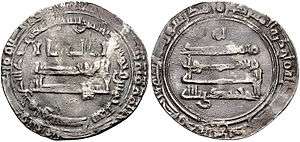Al-Muhtadi
Abū Isḥāq Muḥammad ibn al-Wāṯiq (died 21 June 870), better known by his regnal name al-Muhtadī bi-'llāh (Arabic: المهتدي بالله, "Guided by God"), was the Caliph of the Abbasid Caliphate from July 869 to June 870, during the "Anarchy at Samarra".
| Al-Muhtadi المهتدي | |
|---|---|
| Khalīfah Amir al-Mu'minin | |
 | |
| 14th Caliph of the Abbasid Caliphate | |
| Reign | 21/22 July 869 — 21 June 870 |
| Predecessor | al-Mu'tazz |
| Successor | al-Mu'tamid |
| Born | Samarra, Abbasid Caliphate now Iraq |
| Died | 21 June 870 Samarra, Abbasid Caliphate now Iraq |
| Burial | Samarra |
| Issue | Ishaq ibn al-Muhtadi |
| Dynasty | Abbasid |
| Father | al-Wathiq |
| Mother | Qurb |
| Religion | Sunni Islam |
Early life

Al-Muhtadi's mother was Qurb, a Greek slave.[1] After the death of his father, Caliph al-Wathiq (r. 842–847) in August 847, there were some officials who wanted to elect the young al-Muhtadi as caliph, but in the end, their choice fell on his uncle, al-Mutawakkil (r. 847–861).[2]
Caliphate
After the deposition and murder of his cousin al-Mu'tazz (r. 866–869) on 15 July 869, the leaders of the Turkish guard chose al-Muhtadi as the new Caliph on 21/22 July.[2] As a ruler, al-Muhtadi sought to emulate the Umayyad caliph Umar ibn Abd al-Aziz,[2] widely considered a model Islamic ruler.[3] He therefore lived an austere and pious life—notably removing all musical instruments from the court—and made a point of presiding in person over the courts of grievances (mazalim), thus gaining the support of the common people.[2][4] Combining "strength and ability", he was determined to restore the Caliph's authority and power,[2] that had been eroded during the ongoing "Anarchy at Samarra" by the squabbles of the Turkish generals.[5]
Al-Muhtadi faced Alid risings in the provinces, but the main threat to his power were the Turkish commanders.[2] The dominant figure of the first months of his rule was Salih ibn Wasif, but he too failed to provide enough revenue to pay the troops. Although he executed the previous vizier, Ahmad ibn Isra'il, and his extortion of the secretaries (kuttab), his power continued to wane.[4] His main rival, Musa ibn Bugha, used the opportunity to return from his semi-exile in Hamadhan, arriving in Samarra in December 869. There he constrained al-Muhtadi to take an oath to punish Salih for having robbed the treasures of Kabiha, the mother of al-Mu'tazz. Salih went into hiding, whereupon the Turks mutinied and almost deposed al-Muhtadi. They relented only when he promised them to pardon Salih, but when Salih did not appear, his soldiers began to pillage Samarra, until Musa and his troops scattered them. Soon after, Salih was discovered and executed by Musa's men. Musa thus established himself as the leading official of the government, with Sulayman ibn Wahb as his chief secretary.[2]
Historian Khatib states that he adopted perpetual fasting since the day of his leadership until his murder.
Downfall and death
When Musa left to campaign against the Kharijites, al-Muhtadi took the opportunity to incite the people against him and his brother, Muhammad. Muhammad was brought to trial on accusations of embezzlement and was condemned. Although al-Muhtadi had promised a pardon, Muhammad was executed. This cemented the rift with Musa: the latter marched on the capital with his army, and defeated the troops loyal to the Caliph. He refused to abdicate, but tried to preserve his life and office by recourse to the religious status of the caliph, and the support of the people. He was nevertheless murdered on 21 June 870, and replaced by his cousin, al-Mu'tamid (r. 870–892).[2]
References
- Kennedy 2006, p. 173.
- Zetterstéen & Bosworth 1993, pp. 476–477.
- Cobb 2000, pp. 821–822.
- Kennedy 2004, p. 173.
- Kennedy 2004, pp. 169–173.
Sources
- Cobb, P. M. (2000). "ʿUmar (II) b. ʿAbd al-ʿAzīz". In Bearman, P. J.; Bianquis, Th.; Bosworth, C. E.; van Donzel, E. & Heinrichs, W. P. (eds.). The Encyclopaedia of Islam, New Edition, Volume X: T–U. Leiden: E. J. Brill. pp. 821–822. ISBN 90-04-11211-1.
- Kennedy, Hugh (2004). The Prophet and the Age of the Caliphates: The Islamic Near East from the 6th to the 11th Century (Second ed.). Harlow: Longman. ISBN 978-0-582-40525-7.
- Kennedy, Hugh (2006). When Baghdad Ruled the Muslim World: The Rise and Fall of Islam's Greatest Dynasty. Cambridge, Massachusets: Da Capo Press. ISBN 978-0-306814808.
- Waines, David, ed. (1992). The History of al-Ṭabarī, Volume XXXVI: The Revolt of the Zanj, A.D. 869–879/A.H. 255–265. SUNY Series in Near Eastern Studies. Albany, New York: State University of New York Press. ISBN 978-0-7914-0763-9.
- Zetterstéen, K. V. & Bosworth, C. E. (1993). "al-Muhtadī". In Bosworth, C. E.; van Donzel, E.; Heinrichs, W. P. & Pellat, Ch. (eds.). The Encyclopaedia of Islam, New Edition, Volume VII: Mif–Naz. Leiden: E. J. Brill. pp. 476–477. ISBN 90-04-09419-9.
Al-Muhtadi Born: ? Died: 870 | ||
| Sunni Islam titles | ||
|---|---|---|
| Preceded by Al-Mu'tazz |
Abbasid Caliph 21/22 July 869 – 21 June 870 |
Succeeded by Al-Mu'tamid |